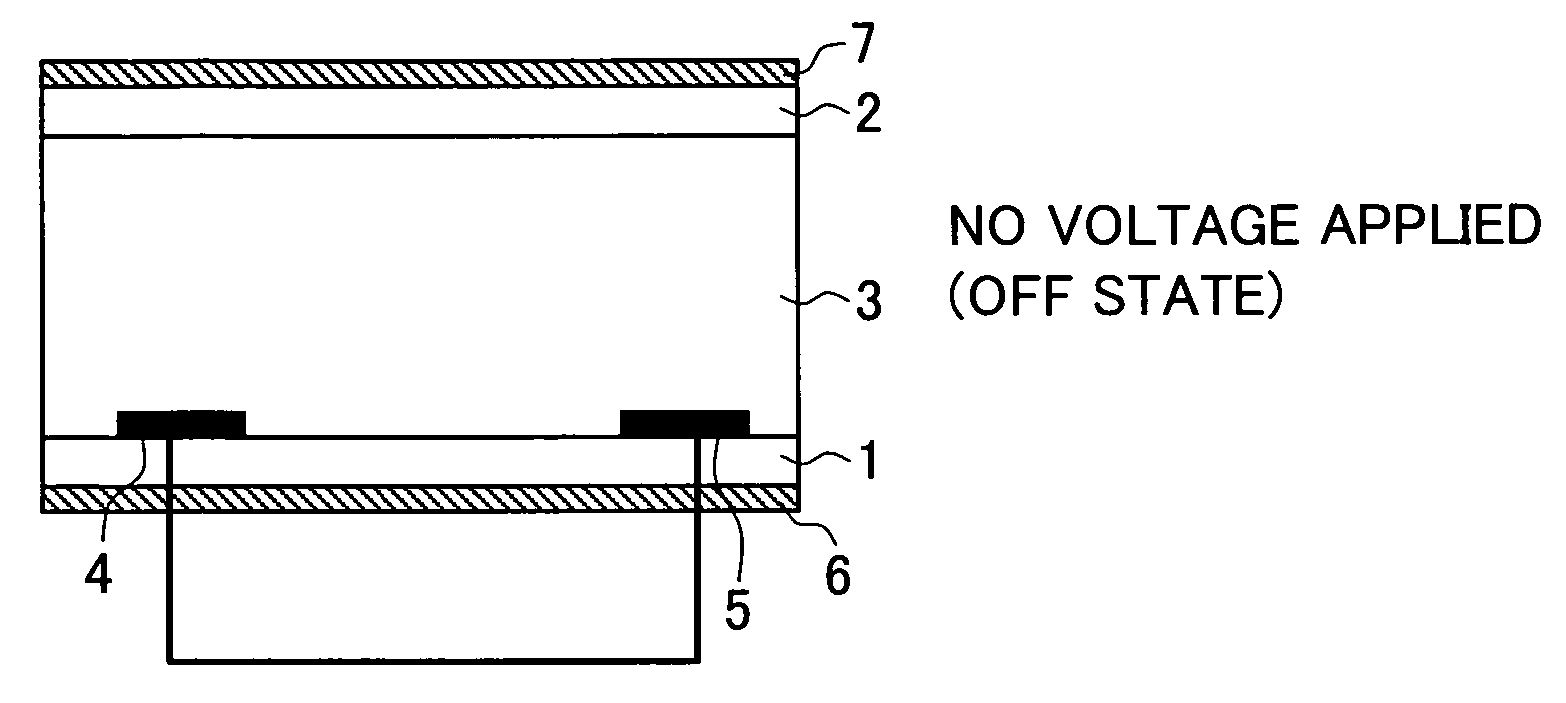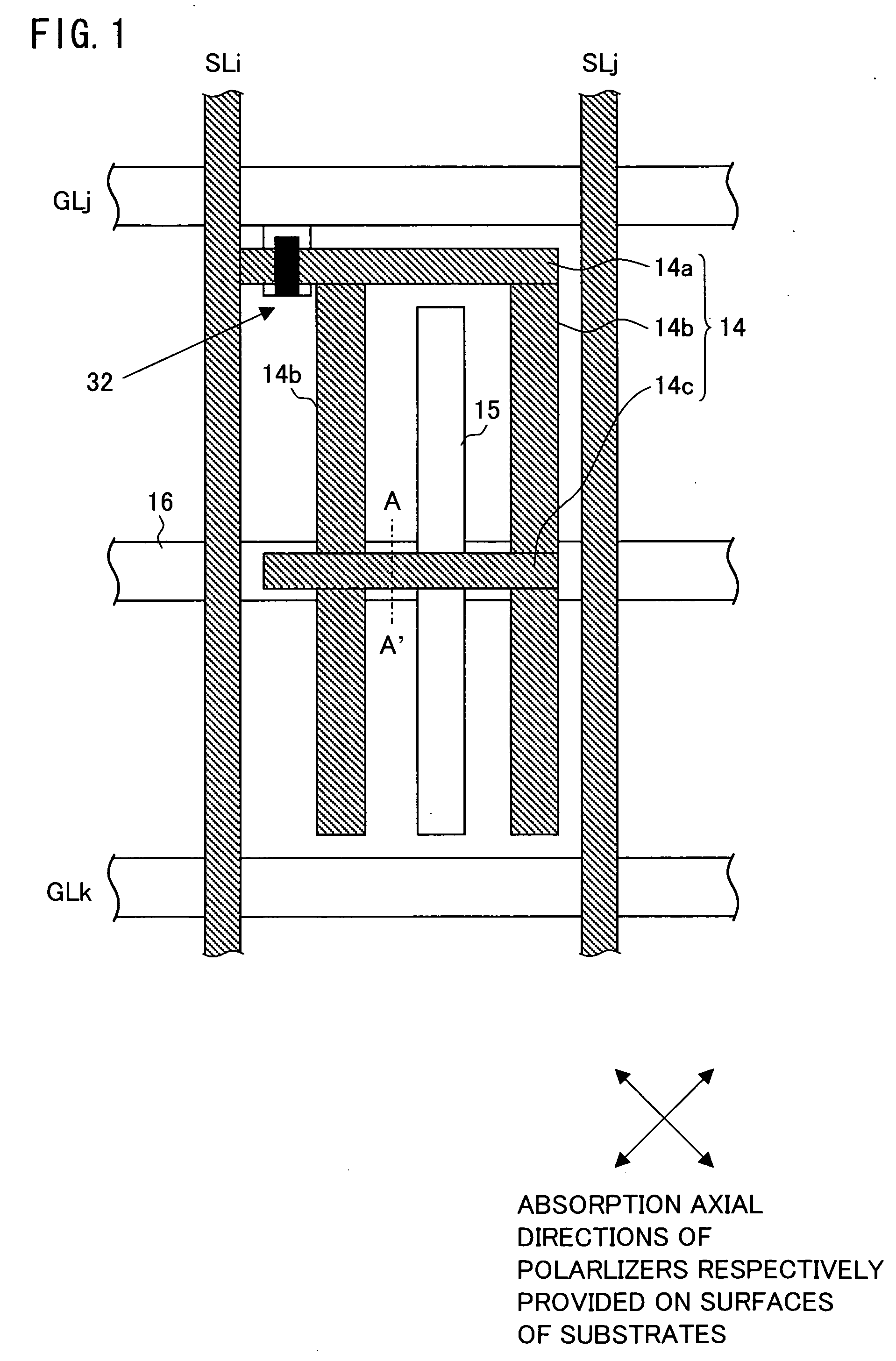Display element and display apparatus
a display element and display element technology, applied in the field of display elements, can solve the problems of prone to contamination, inability to maintain the charge in the display element, and delay in image display, so as to reduce the degree of change in the entire capacitance of the display element is relatively small, and the concentration of impurity ions is apt to increase.
- Summary
- Abstract
- Description
- Claims
- Application Information
AI Technical Summary
Benefits of technology
Problems solved by technology
Method used
Image
Examples
example 1
Cubic Phase
[0132] It is possible to use a medium made of molecules expressing a cubic phase, as the medium injected and sealed in the dielectric material layer 3 of the present display element.
[0133] The material expressing the cubic phase is, for example, BABH8. BABH8 is in the cubic phase in a wide temperature range from 136.7° C. to 161° C., and the stable voltage transmissivity curve can be obtained in the wide temperature range (about 24K). Therefore, it is extremely easy to carry out the temperature control.
[0134] If an electric field is applied to the dielectric material layer 3 made of BABH8 when within the temperature range that BABH8 expresses the cubic phase, the molecules tends to turn in the electric field direction because the molecules have dielectric anisotropy. This causes a distortion of the structure of the minute regions (crystal-like grating). In other words, the dielectric material layer becomes optical anisotropic according to the electric field application...
example 2
Smectic D Phase (SmD)
[0136] As the medium injected and sealed in the dielectric material layer 3 of the present display element, it is possible to apply a medium which is made of molecules in the smectic D phase which is one of the liquid crystal phases.
[0137] One example of liquid crystal materials in the smectic D phase is ANBC16. Note that, ANBC16 is mentioned in Non-patent Document 1 (Kazuya Saito, and Michio Sorai, “Thermodynamics of a unique thermo-tropic liquid crystal having optical isotropy”, Ekisho, 2001, Vol. 5, No. 1 (p.21, FIG.1, Structure 1 (n=16)) and Non-patent Document 6 (“Handbook of Liquid Crystals”, Wiley-VCH, 1998, vol. 2B (p.888, Table 1, Compound No. 1, Compound 1a, Compound 1a-1)). The example includes ANBC etc. represented by the following chemical formulas (2) and (3).
[0138] 4′n-alkoxy-3′-nitro-biphenyl-4-carboxylic acids X═NO2
[0139] n-15 Cr 127 SmC 187 Cub 198 SmA 2041 I
[0140] The liquid crystal material (ANBC16) is in the smectic D phase in a temper...
example 3
[0143] It is possible to apply a liquid crystal microemulsion as the medium injected and sealed in the dielectric material layer 3 of the present display element. The liquid crystal microemulsion is a generic term (named by Yamamoto, et al.) for a system (mixture system) in which oil molecules of O / W type microemulsion (a system in which droplet-shape water is dissolved in oil (continuous phase) by surfactant) are replaced with thermotropic liquid crystal molecules (see Non-patent Document 2: Jun Yamamoto, “Liquid crystal micro emulsion”, Liquid crystal, 2000, Vol. 4, No. 3, pp.248-254).
[0144] A concrete example of the liquid crystal microemulsion is a mixture system of pentylcyanobiphenyl (5CB) mentioned in Non-patent Document 2 and didodecyl ammonium bromide (DDAB) solution. Pentylcyanobiphenyl (5CB) is a thermotropic liquid crystal (temperature transition type liquid crystal) showing a nematic liquid crystal phase, and didodecyl ammonium bromide (DDA...
PUM
| Property | Measurement | Unit |
|---|---|---|
| thickness | aaaaa | aaaaa |
| distance | aaaaa | aaaaa |
| width | aaaaa | aaaaa |
Abstract
Description
Claims
Application Information
 Login to View More
Login to View More - R&D
- Intellectual Property
- Life Sciences
- Materials
- Tech Scout
- Unparalleled Data Quality
- Higher Quality Content
- 60% Fewer Hallucinations
Browse by: Latest US Patents, China's latest patents, Technical Efficacy Thesaurus, Application Domain, Technology Topic, Popular Technical Reports.
© 2025 PatSnap. All rights reserved.Legal|Privacy policy|Modern Slavery Act Transparency Statement|Sitemap|About US| Contact US: help@patsnap.com



